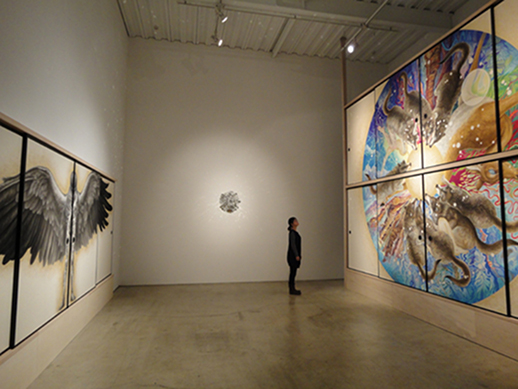Climbing the Hidden Mountain
Tomoko Konoike’s latest exhibition is a richly imagined indulgence in fantasy that appeals to the girl inside us all. It opens with a poem by the artist, included on the exhibition’s flyer (an English translation is available at the venue). In these verses, titled “You Who Are Looking—What Are You Looking At?”, Konoike muses on the subject of viewing and creating. Konoike takes inspiration from nature, describing her artistic process as “elaborating upon and defying it/ Then a Hidden Mountain quietly emerges underground”. The exhibition that follows this introduction is a beautiful and fantastical array of imagery that expands on Konoike’s already-established art universe.
Konoike seems to revel in many different types of fantasy. This exhibition nods to J. R. R. Tolkien, Christina Rossetti’s fairylands, and a Shinto-esque personification of nature. There are magical transformations, strange adventures and worlds without people. I have a deep affection for the work of Tomoko Konoike. Viewing her work is like going back to my girlhood and the extensive imagination I had back then. Where did it go? I think I lost it sometime after eleven-years-old, when I could no longer think of anything for my dolls to say to one another. Konoike, on the other hand, seems to have retained her girlish sense of make-believe to make art that is sometimes epic, sometimes cute, and always from the imaginary world.

Fantasy has a long history of female-centric authorship. Looking back at the works of Rossetti, for example, or Ursula K. Le Guin, or even J. K. Rowling, women have used the genre of fantasy to expose or express a desire for something unavailable to women in the ‘real’ world. In its most feminist of incarnations, emphasis is often on ideas of bodily transformation or gender separatism. Especially in Japan, fantasy finds a special home within girls’ culture. Dreams, metamorphoses, magical women, and magical other worlds are often found among the novels, manga and anime made for Japanese girls and young women. Literary scholars such as Masuko Honda are devoted to analysing the texts of their girlhoods to find a rich, creative community of girl-centric expression bonded by a ‘girl consciousness’.
Konoike’s sculptures, drawings, paintings and animations depict worlds populated by fantastical creatures. She reinterprets maps. She finds magic where there may have been none recognised before. Heian era heroes and heroines pop out of history books, and hybrid creatures float toward the Earth’s core. In a Tolkien-esque gesture, this exhibition features large annals opened up to the middle pages, on which maps of fantastical worlds are displayed. The Earth – or an Earth – is drawn in dissection to display the mappings of her small and magical worlds. The maps consist of volcanoes, books, trees, little furry ball creatures (named Mimio by the artist) and ribbon-like rivers traveling from the core to the surface.
Although the works themselves are not very action-driven, Konoike’s poem is full of adventurous imagery. She writes, “And the viewer tries their utmost to see/ The light of life in what is not alive/ Seeing is like coming across the Sun at the centre of the Earth”. In writing this, the artist reminds us that art can be an adventure. Not only does Konoike want to have the adventure of being an artist, she wishes for her viewers to climb that mountain too.
Emily Wakeling
Emily Wakeling



